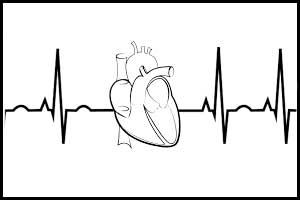- Home
- Editorial
- News
- Practice Guidelines
- Anesthesiology Guidelines
- Cancer Guidelines
- Cardiac Sciences Guidelines
- Critical Care Guidelines
- Dentistry Guidelines
- Dermatology Guidelines
- Diabetes and Endo Guidelines
- Diagnostics Guidelines
- ENT Guidelines
- Featured Practice Guidelines
- Gastroenterology Guidelines
- Geriatrics Guidelines
- Medicine Guidelines
- Nephrology Guidelines
- Neurosciences Guidelines
- Obs and Gynae Guidelines
- Ophthalmology Guidelines
- Orthopaedics Guidelines
- Paediatrics Guidelines
- Psychiatry Guidelines
- Pulmonology Guidelines
- Radiology Guidelines
- Surgery Guidelines
- Urology Guidelines
AHA , ACC Guideline for Management of ventricular arrhythmias

The American Heart Association (AHA), American College of Cardiology (ACC) and Heart Rhythm Society (HRS) have developed a guideline for the management of patients with ventricular arrhythmias and the prevention of sudden cardiac death (SCD).
The guideline is published in the journal JAMA Cardiology.
This synopsis focuses on recommendations on managing Ventricular Arrhythmias, VA and Sudden Cardiac Death, SCD risk that is associated with cardiac channelopathies. All implantable cardioverter-defibrillator (ICD) recommendations require that patients have meaningful survival of greater than 1 year.
Key Recommendations:
- In first-degree relatives of patients who have a causative mutation for long QT syndrome, catecholaminergic polymorphic ventricular tachycardia, short QT syndrome, or Brugada syndrome, genetic counseling and mutation-specific genetic testing are recommended.
In patients with a cardiac channelopathy and sudden cardiac arrest, an ICD is recommended.
In patients with long QT syndrome with a resting corrected QT interval greater than 470 milliseconds, a β-blocker is recommended.
In high-risk patients with symptomatic long QT syndrome in whom a β-blocker is ineffective or not tolerated, an intensification of therapy with additional medications (guided by considering the particular long QT syndrome type), left cardiac sympathetic denervation, and/or an ICD is recommended.
In patients with long QT syndrome and recurrent appropriate ICD shocks despite receiving the maximum tolerated doses of a β-blocker, an intensification of medical therapy with additional medications (guided by considering the particular long QT syndrome type) or left cardiac sympathetic denervation is recommended.
In patients with clinically diagnosed long QT syndrome, genetic counseling and genetic testing are recommended.
In patients with suspected long QT syndrome, ambulatory electrocardiographic monitoring, recording the electrocardiogram (ECG) lying down and immediately on standing, and/or treadmill exercise testing can be useful for establishing a diagnosis and monitoring the response to therapy.
In asymptomatic patients with long QT syndrome and a resting corrected QT interval of less than 470 milliseconds, long-term therapy with a β- blocker is reasonable.
In patients with catecholaminergic polymorphic ventricular tachycardia, a β-blocker is recommended.
In patients with catecholaminergic polymorphic ventricular tachycardia and recurrent sustained VT or syncope, while the patient is receiving adequate or maximally tolerated β-blocker, treatment intensification with either combination medication therapy (eg, beta blocker, flecainide), left cardiac sympathetic denervation, and/or an ICD is recommended.
In patients with catecholaminergic polymorphic ventricular tachycardia and clinical ventricular tachycardia (VT) or exertional syncope, genetic counseling and genetic testing are reasonable.
In asymptomatic patients with only an inducible type 1 Brugada electrocardiographic pattern, observation without therapy is recommended.
In patients with Brugada syndrome with a spontaneous type 1 Brugada electrocardiographic pattern and cardiac arrest sustained VA, or a recent history of syncope presumed to be caused by VA, an ICD is recommended.
In patients with Brugada syndrome who are experiencing recurrent ICD shocks for polymorphic VT, an intensification of therapy with quinidine or catheter ablation is recommended.
In patients with spontaneous type 1 Brugada electrocardiographic pattern and symptomatic VA who either are not candidates for or decline to have an ICD implanted, quinidine or catheter ablation is recommended.
In patients with suspected Brugada syndrome in the absence of a spontaneous type 1 Brugada electrocardiographic pattern, a pharmacological challenge using a sodium channel blocker can be useful for diagnosis.
In asymptomatic patients with an early repolarization pattern on ECG, observation without treatment is recommended.
In patients with early repolarization pattern on ECG results and cardiac arrest or sustained VA, an ICD is recommended.
For further information click on the link: 10.1001/jamacardio.2018.1116

Disclaimer: This site is primarily intended for healthcare professionals. Any content/information on this website does not replace the advice of medical and/or health professionals and should not be construed as medical/diagnostic advice/endorsement or prescription. Use of this site is subject to our terms of use, privacy policy, advertisement policy. © 2020 Minerva Medical Treatment Pvt Ltd